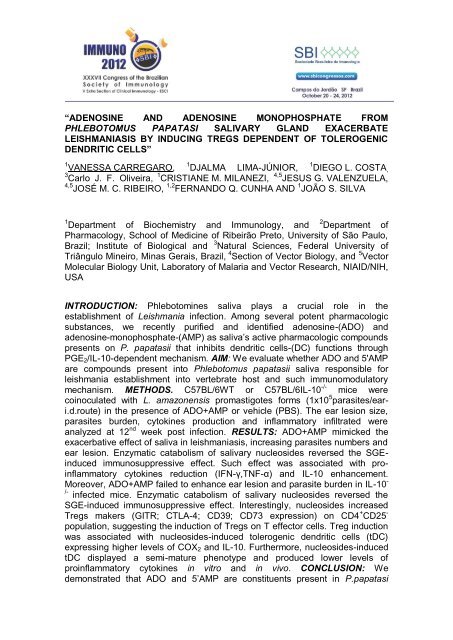immunology of infectious and parasitic diseases - XXXVII Congress ...
immunology of infectious and parasitic diseases - XXXVII Congress ...
immunology of infectious and parasitic diseases - XXXVII Congress ...
Create successful ePaper yourself
Turn your PDF publications into a flip-book with our unique Google optimized e-Paper software.
“ADENOSINE AND ADENOSINE MONOPHOSPHATE FROM<br />
PHLEBOTOMUS PAPATASI SALIVARY GLAND EXACERBATE<br />
LEISHMANIASIS BY INDUCING TREGS DEPENDENT OF TOLEROGENIC<br />
DENDRITIC CELLS”<br />
1 1 1<br />
VANESSA CARREGARO, DJALMA LIMA-JÚNIOR, DIEGO L. COSTA,<br />
3 1 4,5<br />
Carlo J. F. Oliveira, CRISTIANE M. MILANEZI, JESUS G. VALENZUELA,<br />
4,5 1,2 1<br />
JOSÉ M. C. RIBEIRO, FERNANDO Q. CUNHA AND JOÃO S. SILVA<br />
1 2<br />
Department <strong>of</strong> Biochemistry <strong>and</strong> Immunology, <strong>and</strong> Department <strong>of</strong><br />
Pharmacology, School <strong>of</strong> Medicine <strong>of</strong> Ribeirão Preto, University <strong>of</strong> São Paulo,<br />
Brazil; Institute <strong>of</strong> Biological <strong>and</strong> 3 Natural Sciences, Federal University <strong>of</strong><br />
Triângulo Mineiro, Minas Gerais, Brazil, 4 Section <strong>of</strong> Vector Biology, <strong>and</strong> 5 Vector<br />
Molecular Biology Unit, Laboratory <strong>of</strong> Malaria <strong>and</strong> Vector Research, NIAID/NIH,<br />
USA<br />
INTRODUCTION: Phlebotomines saliva plays a crucial role in the<br />
establishment <strong>of</strong> Leishmania infection. Among several potent pharmacologic<br />
substances, we recently purified <strong>and</strong> identified adenosine-(ADO) <strong>and</strong><br />
adenosine-monophosphate-(AMP) as saliva‟s active pharmacologic compounds<br />
presents on P. papatasii that inhibits dendritic cells-(DC) functions through<br />
PGE2/IL-10-dependent mechanism. AIM: We evaluate whether ADO <strong>and</strong> 5'AMP<br />
are compounds present into Phlebotomus papatasii saliva responsible for<br />
leishmania establishment into vertebrate host <strong>and</strong> such immunomodulatory<br />
mechanism. METHODS. C57BL/6WT or C57BL/6IL-10 -/- mice were<br />
coinoculated with L. amazonensis promastigotes forms (1x10 5 parasites/eari.d.route)<br />
in the presence <strong>of</strong> ADO+AMP or vehicle (PBS). The ear lesion size,<br />
parasites burden, cytokines production <strong>and</strong> inflammatory infiltrated were<br />
analyzed at 12 nd week post infection. RESULTS: ADO+AMP mimicked the<br />
exacerbative effect <strong>of</strong> saliva in leishmaniasis, increasing parasites numbers <strong>and</strong><br />
ear lesion. Enzymatic catabolism <strong>of</strong> salivary nucleosides reversed the SGEinduced<br />
immunosuppressive effect. Such effect was associated with proinflammatory<br />
cytokines reduction (IFN-γ,TNF-α) <strong>and</strong> IL-10 enhancement.<br />
Moreover, ADO+AMP failed to enhance ear lesion <strong>and</strong> parasite burden in IL-10 -<br />
/- infected mice. Enzymatic catabolism <strong>of</strong> salivary nucleosides reversed the<br />
SGE-induced immunosuppressive effect. Interestingly, nucleosides increased<br />
Tregs makers (GITR; CTLA-4; CD39; CD73 expression) on CD4 + CD25 -<br />
population, suggesting the induction <strong>of</strong> Tregs on T effector cells. Treg induction<br />
was associated with nucleosides-induced tolerogenic dendritic cells (tDC)<br />
expressing higher levels <strong>of</strong> COX2 <strong>and</strong> IL-10. Furthermore, nucleosides-induced<br />
tDC displayed a semi-mature phenotype <strong>and</strong> produced lower levels <strong>of</strong><br />
proinflammatory cytokines in vitro <strong>and</strong> in vivo. CONCLUSION: We<br />
demonstrated that ADO <strong>and</strong> 5‟AMP are constituents present in P.papatasi



